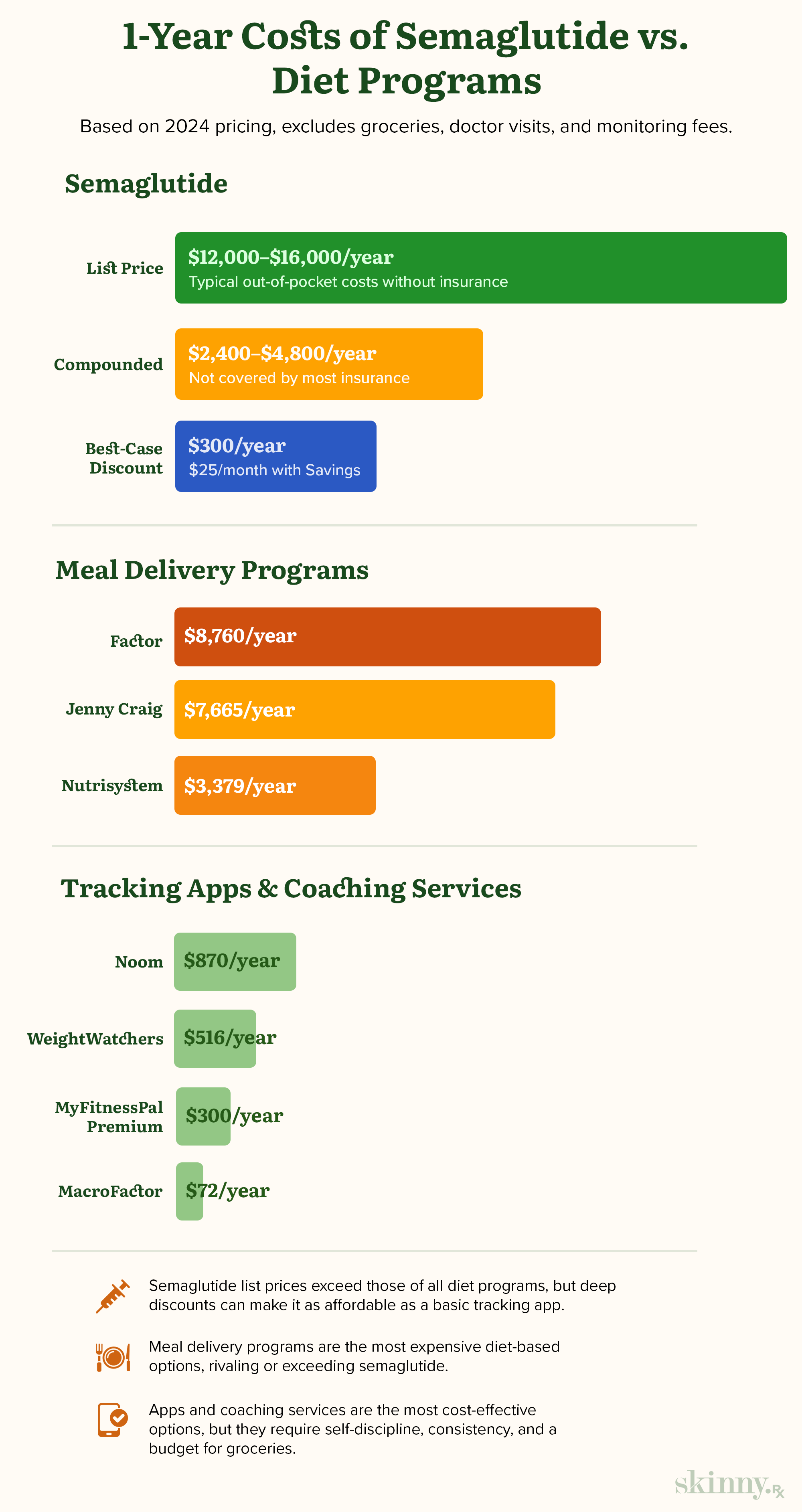
Key Takeaways
Choosing between semaglutide and diet programs comes down to more than just the sticker price. Here are the most critical insights from the cost breakdown, clinical data, and long-term considerations:
- Semaglutide is expensive at list price, over $1,000 per month, but savings cards and promotions can reduce it to as little as $25.
- Meal delivery programs like Jenny Craig and Factor rival semaglutide in yearly cost, while Nutrisystem sits in the mid-range.
- Apps and coaching platforms such as Noom and WeightWatchers come at a lower overall investment, offering structured guidance without providing food.
- Clinical data show that semaglutide users lose significantly more weight than those relying on apps or coaching, though stopping the drug often leads to regain.
- Diet programs emphasize education and habit-building, while semaglutide provides physiological appetite control that works as long as treatment continues.
The Price of Weight Loss
There’s a cost to losing weight, and we’re not talking about having to refurbish your wardrobe. In the wellness industry, it’s all too easy to feel paralyzed by choice—should you take the plunge on semaglutide, or give a meal prep service a go? What about guided dieting services, or smartphone apps?
After all, there’s no such thing as a free lunch. Sticking to a weight loss regimen, no matter what tools you’re arming yourself with, comes with a financial burden.
So, we’re going to break down exactly what it costs to use semaglutide for weight loss, and how GLP-1 agonists (found in Ozempic, Wegovy, and so on) compare to popular alternatives.
Why Cost Matters
You’ve seen it everywhere by now, but you might be surprised to learn that semaglutide comes with a hefty price tag attached. For example, uninsured folks paid around $1,349 a month for Wegovy in 2024. Based on the outsized demand, it’s unlikely prices will fall anytime soon.
For a lot of people, that amount of money stacks up to rent, childcare, or other essential costs of living, which puts the “luxury” of pharmaceutical weight loss under the microscope.
Before you take the plunge on Ozempic, Wegovy, or any similar intervention, you deserve to know whether you’re getting a good deal.
Semaglutide Costs Breakdown
One big thing: Semaglutide is not available over the counter. You need a prescription for Ozempic, Wegovy, Rybelsus, and so on. And they may be partially covered, or not covered at all—as is the case for compounded semaglutide, despite being generally less expensive—by your insurance.
List Prices vs. Insurance Coverage
The list prices for popular semaglutide brands are as follows. This is roughly what you’d pay out of pocket on a monthly basis, as most health insurance companies won’t back semaglutide prescriptions solely for weight loss:
- Ozempic: $997.58
- Wegovy: $1,349.02
- Rybelsus: $997.58
Compounded semaglutide, a “bespoke” version of the drug crafted in-house at pharmacies, typically runs in the realm of $200-$400 per month.
However, maker Novo Nordisk does offer promotions that may significantly reduce cost, alongside variable reductions provided by your health insurance. Nordisk stresses on its website that most people don’t pay the full price—you may be able to get ahold of semaglutide for as little as $25 per month through select promotions offered by the maker, like the Ozempic Savings Card.
Doctor Visits & Monitoring Fees
Of course, even if you do get your semaglutide at a steep discount, it’s still wise to take it as prescribed and under the care of a medical professional, which will add to the financial burden.
Expect to have somewhat frequent doctor visits while you’re adjusting to the medication. Even with insurance, these visits and the associated copays can add up.
The Big Picture
The cost of semaglutide can vary tremendously based on whether or not you have insurance, what promotions or coupons you have access to, and other factors.
If you’re uninsured and unable to obtain discounts, you’re looking at around $1,000 a month—unless you work with SkinnyRX. Regardless, most people who take semaglutide pay substantially less thanks to insurance coverage or promotional discounts.
Diet Program Costs Breakdown
We’ve all heard that diet programs, personal trainers, or meal prep services break the bank—luxuries reserved for the rich and famous. Fortunately, that’s not quite the case anymore. Let’s take a closer look at the cost of some popular diet programs.
Subscription Models
Many popular diet plans promise to put weight loss on autopilot, similar to semaglutide. These programs aim to create weight loss by controlling your caloric intake mainly via specialty meal planning.
- Noom: Their monthly, auto-renewing price for dietary planning and guidance is $70, with discounts available if you sign up for longer periods.
- WeightWatchers: Month-to-month pricing starts at $43, with less and more expensive options available depending on the level of support you’re looking for.
Then there are meal delivery services, which take cooking out of the equation almost entirely:
- Jenny Craig: Auto-ship plans, which deliver meals to your door, start around $21 a day for breakfast, lunch, and dinner.
- Nutrisystem: Their basic meal delivery plan starts at $64.99 a week.
- Factor: Factor ships ready-to-eat meals in bulk, which cost approximately $10-14 each.
Worth noting: Many of these services will provide “hidden” discounts or promotional offers if you cancel during the trial period. They also have fitness & nutritional guidance services provided by paid applications.
- MacroFactor: Food logging, body metric tracking, and more, starting at $5.99 per month.
- MyFitnessPal: Offers a free version as well as a premium service with expanded features like a custom meal planner and recipe library for $24.99 monthly.
The Big Picture
Platforms and services that assist with or provide guidance on healthy eating for weight loss are cheaper than you think.
However, meal delivery services or food tracking apps don’t directly change your behavior the way semaglutide can. The impetus is fully on you as the consumer to utilize these services if you want to get your money’s worth.

Ultimately, there is no one right answer to choosing a medication and/or diet program. There are many helpful tools in the toolbox, and the best approach comes down to your goals, budget, and what fits best in your lifestyle.
–
Whitney Linsenmeyer, PhD, RD, Assistant Professor of Nutrition and Dietetics
Head-to-Head Comparison
Let’s take a closer look at how semaglutide vs. diet programs stack up against each other, beyond just the price tags.
1 Year of Semaglutide vs. Top Diets
Remember, the price of semaglutide medication can vary drastically depending on whether you’re covered by insurance, paying out of pocket, or other factors.
Let’s assume a best-case scenario where you’re receiving a GLP-1 prescription for as low as $25 a month. Over a full year, that’s $300. Across the same period, using the most basic option found with other methods, you’d pay…
- $840 for dietary guidance through Noom
- $516 with WeightWatchers
- $7,665 for three Jenny Craig meals delivered every day of the year
- $3,379 for meals from Nutrisystem
- $8,760 for two meals a day, every day of the year, from Factor
- $72 for a year of MacroFactor use
- $300 to use MyFitnessPal Premium for a year
Put simply: If you’re getting semaglutide at a great discount, it measures up comparably to what you’d pay for a food logging app or dietary guidance service.
Plans that deliver meals directly to you run substantially more if you use them long-term—but consider that you should be spending far less at the grocery store, since these programs often take the prep of two out of three daily meals off your plate, so to speak.

Long-Term Costs
Weight loss phases are generally planned out over a period of several months, but the financial strain can last longer.
Consider the tangential medical costs that come with long-term use of a drug that requires monitoring, or the risk of rebounding after your protocol ends, and having to start over again. Semaglutide does not teach you how to eat properly to maintain your weight, it’s simply a potent appetite regulator.
That strategy can work wonders short term, but without the proper educational resources (which many of these services provide), you might find yourself back at square one after coming off semaglutide.
That strategy typically works wonders in the short term. But if you don’t take the time to educate yourself, an advantage offered by many diet programs or mean plans, you might find yourself back at square one.
Some data show that, a year after coming off semaglutide, folks can gain back as much as two-thirds of the weight they lost.

Explore GLP-1 Weight-loss Options
Take a short, personalized quiz to discover whether GLP-1 medications could be the right choice for your wellness journey.
Effectiveness: What You Get for the Money
Let’s look past price and examine the value you get from semaglutide vs. dietary plans. If all interventions worked similarly, price would be the only factor that matters—but they don’t, so it isn’t. Here’s what you need to know.
Clinical Weight Loss Data
In 2024, a systematic review (which collects existing data and draws broader conclusions) found that using semaglutide for weight loss vs. a placebo lost 27 more pounds on average. Over a year after they stopped taking it, around a third of participants had maintained substantial (greater than 20%) weight loss—only 2% of the placebo group held onto similar progress.
Older data supports a similar level of change; semaglutide users lost significantly more weight than those taking a placebo.
High-quality data on how well meal delivery services or apps work for weight loss is harder to come by—one study from 2014 observed “no significant difference” between MyFitnessPal users and standard dieters, though the researchers did acknowledge the apps’ utility in monitoring caloric intake.
More recently, a 2022 meta analysis of 34 existing studies concluded, “Smartphone apps have a role in weight loss, [but] … the human-based behavioral component remained key to higher results.”
Dropout Rates & Adherence
Studies report issues with adherence to semaglutide which often center around patient hesitation to administering their own injections. That aside, one of the reasons semaglutide has become so popular is its ease of use—reducing your appetite and desire to overeat.
By contrast, meal delivery services require labor and preparation, and inputting macronutrients daily into an app can be tedious. When it comes to successful dieting, adherence is king. Whatever method helps you stick to your plan will generally work best.
Long-Term Considerations
On paper, semaglutide has a lot going for it that meal services, weight loss coaching, or apps can’t match. The simplest way to support weight loss is to maintain a calorie deficit, a decision that semaglutide makes easier.
That said, “eating less” is hardly a holistic, long-term approach to nutrition. Semaglutide may make it easy to lose weight in the short term, but if you don’t arm yourself with knowledge about how to feed and fuel yourself properly, you might find yourself back where you started once you come off.
That’s one undeniable advantage of a service like MacroFactor, Jenny Craig, or Noom—a direct, hands-on approach to nutrition can help you build good habits that you can keep with you long after you stop forking over your hard-earned money.
Who Should Choose Semaglutide
Let’s talk real-world. Semaglutide might be suitable for you if you have a BMI at or above 30, which the National Institute of Health regards as a threshold for weight loss medication prescription, or a BMI of 27 with certain comorbidities. In any case, this decision rests between you and your doctor.
If you have lots of weight to lose and other diet programs haven’t worked for you in the past, a physiological intervention like semaglutide can get the ball rolling without requiring you to turn your lifestyle inside out.
Who Should Stick to Diet Programs
If you have a modest amount of weight to lose or are looking to trim up for a specific occasion, semaglutide can work. However, it might be overkill if you already have a scant appetite or if you can’t get it prescribed.
Sound like you? Stick to diet programs—doubly so if you feel you need to brush up on what constitutes healthy eating, including portion control, protein intake, calorie tracking, and learning about your hunger and satiety cues.
These services require more legwork on your end, but they’ll also teach you more about what your body needs.
Can You Combine Both?
In short, yes. Semaglutide and diet programs don’t work through the same mechanisms, so you’re fine to double down if you like.
In fact, using a calorie tracking app can be an asset while taking semaglutide if you find yourself drastically undereating and need to hit your protein or calorie quotas for the day.
However, consider the cost—things can add up quickly if you’re taking semaglutide, subscribing to a fitness tracker app, and getting some meals delivered on the side. Any substantial change, such as outsourcing your meal prep, should be discussed with your doctor before you take the plunge.
Practically speaking, your best bet is to make one change at a time, see how it affects your body (and your budget), and adjust from there.
Final Thoughts
- Despite its popularity, semaglutide can be quite expensive in certain niche cases.
- Traditional interventions like meal plans or nutritional coaching have become cheaper over the years, but can balloon in cost if you use them full-time.
- List price semaglutide without any deductions can run you around a thousand dollars a month in some cases.
- Semaglutide might be right for you if you have significant weight to lose or certain comorbidities; talk to your doctor first.
- Meal planning or diet coaching are better options for people who need to learn more about proper eating habits, or don’t have much weight to lose.


 Medically Reviewed
Medically Reviewed



